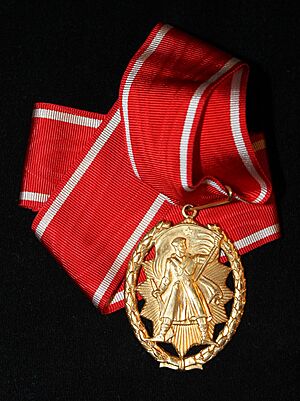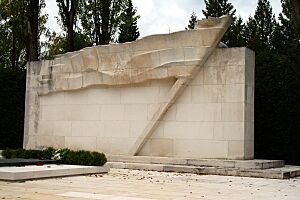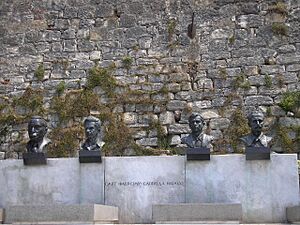Order of the People's Hero facts for kids
Quick facts for kids Order of the People's Hero |
|
|---|---|

Order of the People's Hero medal
|
|
| Presented by | |
The Order of the People's Hero was a special award in Yugoslavia. It was given to people, army groups, and organizations. This award honored those who showed amazing bravery during war and peace. People who received it were called People's Heroes of Yugoslavia. Most of these awards went to brave fighters called Partisans. They earned the award for their actions during World War II. About 1,322 awards were given in Yugoslavia. Also, 19 awards went to people from other countries.
In 1998, a new country called the Federal Republic of Yugoslavia brought back this award. They gave it to several army groups. However, they did not give it to any individuals at that time.
Contents
History of the People's Hero Award
How the Award Started in Yugoslavia
The idea for the "People's Hero" award began in late 1941. It was meant for brave people fighting in the People's Liberation War. This war was part of World War II. The first person to get this title was Petar Leković. In total, 22 people first received this special title.
On August 15, 1943, the title became an official medal, or "order." This new medal was designed by artist Đorđe Andrejević Kun and sculptor Antun Augustinčić. The medal is gold and shows a soldier with a rifle. It hangs from a red ribbon with white stripes. Everyone who had the "People's Hero" title before 1943 also received this new medal.
Who Gave the Award and Its Benefits
At first, a special group called the Central Committee of the KPJ gave out the award. After 1945, the People's Assembly of Yugoslavia decided who got it. From 1953, the President of Yugoslavia made the final decision.
About 1,400 awards were given out until 1993. Josip Broz Tito, the leader of Yugoslavia, received the award three times. This was in 1944, 1972, and 1977. People who received the award got special benefits. For example, they could travel for free on public transport. If a hero died, their family received money. Even today, some countries that used to be part of Yugoslavia still offer benefits. Many schools and streets were named after these heroes. Some of these names are still used today.
Hero Cities and Organizations
Not only people, but also cities, army groups, and other groups received this award. Eight cities in Yugoslavia were named "hero cities." These cities were:
Some public and political groups also received the award. These included the Young Communist League of Yugoslavia and the Union of Veterans of the People's Liberation War.
The Award in Serbia and Montenegro
After Yugoslavia broke apart, a new country called Serbia and Montenegro was formed. In 1998, this new country decided to keep some of the old Yugoslav awards. The Order of the People's Hero was one of them. It became the fourth-highest award in Serbia and Montenegro.
This award was not given to any individuals in Serbia and Montenegro. However, several army groups that fought in the Kosovo War received it. These included:
- 125th Motorized Brigade
- 549th Motorized Brigade
- 37th Motorized Brigade
- 63rd Parachute Brigade
- 124th Police Intervention Brigade
- 126th Air Surveillance Brigade
- 250th Air Defence Missile Brigade
Key Facts About Recipients
By 1981, 1,322 people in Yugoslavia had received the award. Most of them were men (1,231), and 91 were women. Many heroes worked as miners or in factories (34%). About 19% were university or high school students. Another 18% were farmworkers.
Most of the award winners were very young. Half of them joined the army before they turned 25. Only 325 were older than 30. About 42% of the heroes who died in the war were between 16 and 26 years old. Three heroes were even younger than 17 when they died. The youngest person to receive the award was Milka Bosnić. She was only 15 when she was killed during a battle called the Raid on Drvar.
Most awards were given right after World War II, especially between 1951 and 1953. Josip Broz Tito was the only person to receive the award more than once. He got it three times. Of the 955 heroes who died in the war, 77% were killed in fighting. About 15% were executed or died in prison. Around 7% died from their injuries. Most heroes died in 1943 (about 30%) and 1942 (27.5%). Nine heroes were killed after the war ended while fighting enemy groups. Fifty-five People's Heroes chose to end their own lives to avoid being captured.
Most of the heroes were born in Croatia (21.9%), Bosnia and Herzegovina (20.6%), and Montenegro (18.7%). Many of those who died during World War II died in Bosnia and Herzegovina (32%). In 1957, there were 410 living People's Heroes. By 1981, this number was 343. The last living woman to receive the award was Andreana Družina (who lived from 1920 to 2021). The last living male recipient is Petar Matić Dule (born in 1920).
Images for kids
-
Josip Broz Tito was awarded the order three times.
-
President Tito with People's Heroes from PR Bosnia and Herzegovina (1955)
-
Vraca Memorial Park is located in Sarajevo, Bosnia and Herzegovina.
See Also
- Orders and medals of Socialist Yugoslavia
- Orders and medals of Federal Republic of Yugoslavia
- Hero of the Soviet Union
- Hero City
- Hero of the Republic of Cuba











